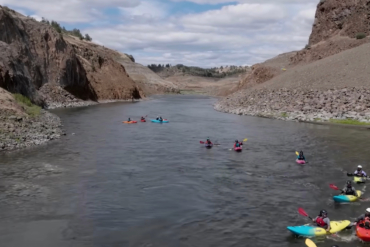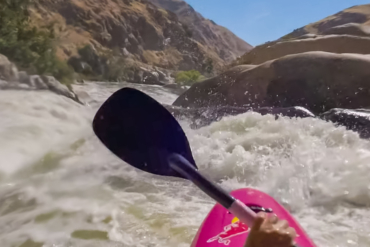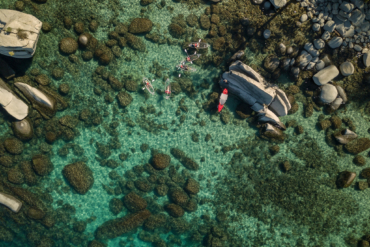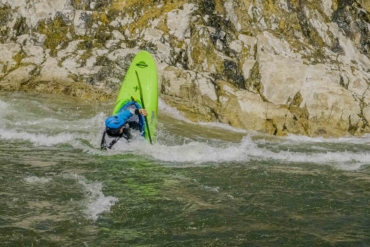I couldn’t contain my excitement. The package came and the green light approval was in. I could finally paddle around Yellowstone Lake, North America’s largest high-elevation lake in the heart of Yellowstone National Park. I grabbed a knife and quickly opened the box, tossed it aside, unzipped the bag, and rolled out the board.
With the included manual pump, I instantly got to work. As the air filled the board, it began to take shape, and my eyebrows rose as much as my excitement.
In short: I was hesitant at first about this inflatable board, but it proceeded to outperform my expectations. I had never even considered doing an expedition of this caliber on an inflatable SUP. But, I had promised deadlines to clients and therefore had no choice but to begin paddling the 110 miles of shoreline along the grizzly-bear-infested waters of Yellowstone National Park.
Luckily, Pau Hana designed this board for touring and expeditions. Things like lashing points for the cargo netting that came with the board and a paddle already part of the kit makes this board a great starter package for paddleboarders who want to venture further out. I stowed everything in the bag, deflated the SUP, and zipped it up. Just like that, I was ready for the drive to the shore to hit the water — 110 miles of it — on the Endurance Air.
- Materials: PVC drop stitch exterior, double layer PVC side rails, EVA deck pad, 23 SeaMount attachment points and D-rings
- Length: 12'0"
- Width: 30"
- Height: 6"
- Volume: 250L
- Paddleboard weight: 24 lbs.
- Weight limit: 263 lbs.
- Fins: 1 (9")
Pros
- Large enough for 1-4-day expeditions (carrying rider plus gear)
- Durable
- Lots of attachment points
- Stable when paddling
Cons
- Smaller deck pad area
- Hard to pump to maximum PSI
Pau Hana Endurance Air Review
First Impressions

The Endurance Air board when inflated is 12 feet long, 30 inches wide, and 6 inches thick. It comes with a single 9-inch fin, an adjustable paddle, and an air pump that all stows into a backpack. Weighing 24 pounds, walking to the shore was a breeze knowing that I still had two hands to carry dry bags and other gear. The color and mahogany patterns on the deck shone in the sun.
As I paddled my first strokes, my confidence in the inflatable board for an overnight expedition grew. Without having any time to test out the board prior to the trip (a gamble, I know), I was happily surprised with its performance. I immediately lowered my doubt about completing the 110-mile trip in 3 days.
The first 2 days of the trip were a mix of sheer joy and some agony from being slightly out of shape, but the Endurance Air board paddled as smoothly as a hot knife through butter. Day 3 was the true test, as the wind was forecast to pick up. But when the 20 knots of wind kicked in and the 2-3-foot waves began changing across the lake, the board plowed through the water as steadily as in flat conditions. It was exactly this performance in both flatwater and chop — even fully loaded with gear — that impressed me the most.
On the Water
After inflating to at least 10 PSI (we recommend 20 or more depending on total weight), I loaded my two dry bags. One was a 115L SealLine Boundary Pack and the other was a smaller SealLine 20L dry bag. With the cargo netting confidently holding down the bags, I slipped the air pump in between the netting and stepped out from the shore and onto the board.
To my surprise, the Endurance Air barely budged under my 200-pound frame. The 5mm deck pad is grippy and comfortable, though it doesn’t cover quite as much surface area as similar-length boards.

Along the rails of the Endurance Air board are 16 welded and seamed attachment points, designed to support Pau Hana’s cargo netting and strap system.
The cargo netting comes in a package of two (but are sold separately from the board). With the cargo nets came eight nylon straps that helped me loop the cargo netting to the attachment D-ring hooks. This came in handy when finally dealing with 2-3-foot waves on my third day of the expedition.
When the cursing began out of frustration in the wind, it was a relief to know that my dry bags, both fore and aft, were sturdy and tied down into place. The nylon straps were the perfect length, about a foot, and very easy to thread through the provided D-rings and cinch into place.
I came relatively close to capsizing a few times on my trip, but luckily the surfer in me kept everything upright. But the cargo netting covered my gear like a warm blanket swaddling a baby. Because of that, I never questioned the nets or straps even if I did capsize, as I was confident my gear wasn’t going anywhere.

Out of the 16 D-rings, I used four of the rings up front to cover my big dry bag, and another four on the tail to hold a smaller dry bag. For weight distribution, especially during slightly more windy and stormy conditions, I pulled my fore dry bag closer to where I stood so the nose of my board could stay above the waves.
On calmer days, I would use the very front two D-rings, port and starboard, to allow more of a waterline to help cut through the sheet glass. The number of attachment points on the board easily allows for wiggle room here so you can properly distribute weight.
The back four D-rings were always the same for me — I’d use them to lash up the back section of netting. (I used this same system for my trip with the Endurance XL, noted in the comparison below.)
Small Downfalls

I will say that pumping to get the board to a PSI that was sturdy enough to hold myself and my gear (~20 PSI) took forever. Now at 250L, that is a lot of volume, but it took well over 15 minutes of pumping. And during my paddle, the rubber sealant gasket fell off of the pump. (Either Pau Hana should fix the O-ring design or provide a spare.)
Aside from the initial inflation, I luckily didn’t need to top the board off. Which is pretty commonplace when you are carrying over 200 pounds of body weight plus gear on any standup paddleboard. Score!
If I’m being picky, the max weight capacity of the board — while on par with other inflatables — was a little low for my liking. I maxed out the weight capacity for the board pretty quickly with myself and gear, around 260 pounds. While it worked and paddled fine at that weight, I would be hesitant to push that weight any further. Depending on how long your expedition is, this 12-foot board, while super capable for its size, might not be enough when it comes to weight capacity.
Comparison: Endurance XL vs. Endurance Air
The obvious difference between these two Pau Hana paddleboards is that the Endurance XL is a hardboard while the Endurance Air is an inflatable. Aside from that, the dimensions of the boards are nearly identical when inflated. At 12 feet long and 30 inches wide, both of these boards have a planer hull design that allows optimal efficiency when on the water and capacity for weight and gear. The deck space and even cargo nets for both are the same.

The real difference between the two comes in the weight capacity. With the Endurance Air capping out at 260 pounds, the Endurance XL skyrockets past that with a 415-pound limit. Now, that’s expected, as one is an inflatable and other a hard board.
For example, the XL has been perfect for my 1,000-mile expedition down the Baja peninsula. But the Air would have been a disaster given the weight capacity of the board. On the flip side, the Endurance Air was perfect for a couple of hundred-mile trip, whereas the XL could be overkill.
The price is also a slight factor in that the Endurance XL is $500 more at $1,749.
It comes down to the trip, the usage, the weight required, the price, and ultimately storage. You will not be able to fold down the XL into the trunk of your car. And the Air won’t be able to handle 260 pounds or more on longer expeditions. For most, the Endurance Air is perfect for overnights whereas the XL is the better choice for longer expeditions.
Conclusion

There are inflatable boards on the market that fold down smaller, weigh less, and perhaps pump better than the Endurance Air. But I’d challenge that none of them can do a multiday expedition like this craft. Once inflated, it’s a guided missile locked on its target. It performed exceedingly well in rough chop and wind. I rubbed it against sharp volcanic rocks and downed trees, and let it sit in the hot sun. Through all that, the Endurance Air’s inflation held up well.
After long hours and several days on the water, the Endurance Air and I were both pumped for what the next day would bring. It’s a great choice for beginner paddlers who plan to get into overnight expeditions, and want a capable and durable board.









